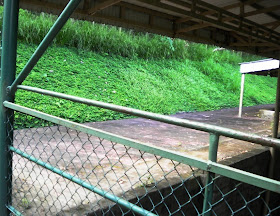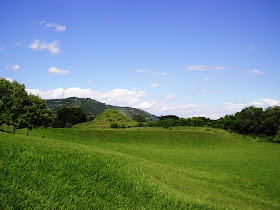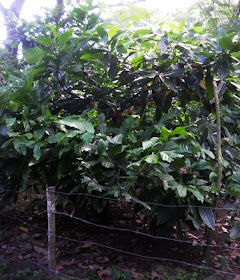 On Monday, Steve and I had intended to see some of El Salvador's archaeological sites. We did not realize they are all closed on that day of the week, so we ended up on the road less traveled which had adventures of its own. We made our second attempt on Tuesday and were so enraptured by the first two sites that we never made it to the one we had intended to visit (Tazumal). Our first stop was San Andrés, located in the Zapotitán Valley behind the volcano San Salvador. The Spanish conquistadors never knew about this site, and it's a good thing for they usually razed Mayan sites to the ground. San Andrés was first noticed in 1891 but the first digs did not occur until the 1940s. In 1977, the Legislative Assembly of El Salvador made it a national monument. It has yielded evidence of human activity dating back three thousand years!
On Monday, Steve and I had intended to see some of El Salvador's archaeological sites. We did not realize they are all closed on that day of the week, so we ended up on the road less traveled which had adventures of its own. We made our second attempt on Tuesday and were so enraptured by the first two sites that we never made it to the one we had intended to visit (Tazumal). Our first stop was San Andrés, located in the Zapotitán Valley behind the volcano San Salvador. The Spanish conquistadors never knew about this site, and it's a good thing for they usually razed Mayan sites to the ground. San Andrés was first noticed in 1891 but the first digs did not occur until the 1940s. In 1977, the Legislative Assembly of El Salvador made it a national monument. It has yielded evidence of human activity dating back three thousand years!
At first, we were a little disappointed because the museum was closed for renovations. As we wandered toward the ruins, Juan Ramón Bonilla came to our rescue. He is a self-educated guide who has been studying Mayan ruins for the past ten years and has been researching the archeaology of these sites. He gave us a personal tour, and his knowledge of the area was extensive and his pride in his heritage was evident in his passion and enthusiasm for the topic. He had answers for related topics such as the four existing Mayan codices and theories of how the Mayas made it to Central America including the one that people from the South Pacific arrived on rafts. He impressed us so much that, when he suggested we visit Joya de Cerren for its scientific appeal, we followed his advice and skipped Tazumal.

When the Spanish conquistadors first arrived in El Salvador, they found no evidence of the Mayas who had left the area half a millenium before. Volcanic eruptions had covered temples, homes, and government buildings completely. In June 1524, Pedro de Alvarado, a lieutenant serving Hernan Cortez, entered Cuscatlan and found the Pipil nation, a farming society, organized around a couple of large cities. The natives resisted the Spaniards rather fiercely, and they did not fall under Spanish rule until 1528.


By the seventeenth century, the Spanish organized the area of San Andrés into a colonial hacienda, setting up cattle ranches and indigo manufacturing near the Sucio River. They built an indigo processing facility within sight of ancient pyramids buried underneath the brilliant green grass growing in the mounds where the cattle fed. In 1658, the volcano El Playón erupted and completely covered the indigo plant, which was not uncovered until 1995 when the developers of the San Andrés Archeaological Park were building the foundation of the museum in that very spot. It makes me wonder what else lies beneath the grounds!

 Along side the colonial indigo pits, we found indigo growing wild. These dull, green leaves yield the brilliant blue that dyed my purse. For over three hundred years, El Salvador led the world in the production of indigo, the only natural source of blue. The Pipils used indigo in medicine, fabric, and ceramics. Because indigo does not dissolve in water, the manufacturers required three different pits to extract the dye. I took a picture of the hill leading down into the pits to give you an idea of how deeply the volcanic lava buried them back in 1658.
Along side the colonial indigo pits, we found indigo growing wild. These dull, green leaves yield the brilliant blue that dyed my purse. For over three hundred years, El Salvador led the world in the production of indigo, the only natural source of blue. The Pipils used indigo in medicine, fabric, and ceramics. Because indigo does not dissolve in water, the manufacturers required three different pits to extract the dye. I took a picture of the hill leading down into the pits to give you an idea of how deeply the volcanic lava buried them back in 1658.

You probably think we had to hack our way through the jungle wielding machetes a la Indiana Jones to reach this site because these pictures make San Andrés seem so remote. All we did was drive down the Pan-American highway, make one turn off the road, and drive into the parking lot. The directions to the site are pretty easy. The lush green grass seems too brilliant to be real for two reasons: we arrived a week after the rainy season ended and the volcanic ash makes the soil highly fertile. Ramón pointed out a spot illustrating the lava flow as we headed toward the pyramids. We even watched flocks of sheep grazing near the old museum while we discussed Mayan civilization.




Around 900 B.C., a farming community developed along the banks of the Sucio River in this valley. Archaeologists believe they were Mayas. How do they know this if only five percent of the site is uncovered? They dug a really deep hole and probed it for artifacts. This pit is the deepest they have dug here and it is NOT the bottom layer of human activity. In 420 A.D., people evacuated this area because of a gigantic eruptions of the volcano Ilopango (now the name of a lake). White volcanic ash, or tierra blanca, spewed everywhere, covering a large part of central and western El Salvador. The layer of ash was over six feet deep. San Andrés and other sites in the area were abandoned for about eighty years.

From 500 to 600 A.D., the Maya started recolonizing the valley, which was sterile until several decades of weathering made the land cultivable. From 600 to 900 A.D., the San Andrés, which covered about two square kilometers, was the largest community in the region and became the center of power where the elite class lived. Ninety-five percent of the settlement lies buried and the rectangles and ridges are the tops of underground structures. The area within these ridges was the seat of power over the people living in the valley past the boundaries. Archaeologists have estimated the park has about a hundred mounds. People in the settlements probably visited the monumental center at San Andrés to pay tribute and attend religious ceremonies.


This monumental center included the Great Plaza and the Acropolis. Pictured below is the Acropolis, which included a large pyramid that probably house royal tombs on the south end. Along the east end are ceremonial and political structures, while the ones along the north and west are probably palaces. Two rooms from the palace have been reconstructed. Many of the monuments found in other Mayan centers had glyphs (writing) carved into the stone. Ramón told us they had probably burned off.






North of the Acropolis is a plaza with another pyramid in the northwest corner. They call the uncovered pyramid the Bell of San Andrés because of its shape and believe it is even larger than the partially uncovered pyramid. Commerce probably took place in the plaza. So much of the site is uncovered is because we have no good ways of preserving structures from the elements of erosion. At present, the best way to prevent slowly destroying these monuments over time is to leave them as they are right now.

South of the Acropolis is a smaller pyramid thought to be for ceremonies. Just south of that is a crater created by volcanic bombs shot out and hurled great distances during an eruptions. I wouldn't want to be on the receiving end of one of those things!



This nut tree was cultivated by the Mayas.

Pictured here is Mayan currency. Fruit, you ask? This is no ordinary fruit. These are cocoa trees with fruit that is processed into the rich, silky treat we all know and love. Imagine having money you can both spend and eat!


I had a hard time capturing pictures of the fauna of El Salvador. Beasts were pretty easy to find but the birds and the butterflies were too fast for me!


oh my!
ReplyDeleteThese photos are so lovely, the top ones look like someone photoshopped you in front of a calendar poster.
How fortunate to be able to see these wonderful places.
Great pictures and description of the site. I'm in El Salvador and havent been able to see the ruins yet, but your webpage is very informative.
ReplyDelete